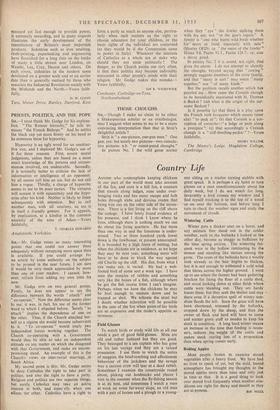THOSE CHOUGHS SIR,—Though I make no claim to be either
a Shakespearian scholar or an ornithologist, may I suggest what seems to me to be a more convincing interpretation than that in Strix's delightful article ?
Strix is " a one-picture, one-gun man." One gun, yes: but surely two pictures—two cumula-. tive pictures: n.b. "or russet-pated choughs."
In picture No. 1 the wild geese scatter when they " eye" the fowler stalking them with his net, not " at the gun's report." A fowler is " one who hunts wild,birds whether for sport or food, especially with nets" (Shorter OED): cp. " the snare of the fowler" Hosea 9.8, Psalm 91.3., Psalm 124.7.: cp. also a decoy pond.
In• picture No. 2 it is sound, not sight, that gives the alarm. I do not attempt to identify the choughs, beyond saying that " cawing " strongly suggests members of the crow family, and that " many in sort " may mean " many together," not " of many kinds."
But the problem recalls another which has puzzled me. How came the Cornish chough to be heraldically associated with St. Thomas a Becket ? and what is the origin of the sur- name Beckett ?
Is it possible (a) that there is a play upon the French verb becqueter which means (inter alia) " to peck at "; (b) that Cornish is a cor- ruption of corniche—"a ledge or path along a precipice "; (c) that accordingly a Cornish chough is a " cliff-dwelling-pecker " ?—Yours faithfully,
HENRY WILLINK The Master's Lodge, Magdalene College. Cambridge


































 Previous page
Previous page